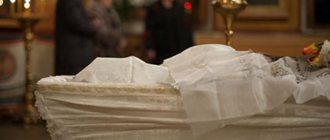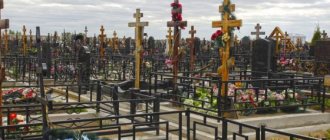The essence and types of funeral services
If the sacrament of baptism means a person’s entry into spiritual life, then the funeral service is a ritual of seeing him off to Heaven. The essence of the memorial service is the liberation of the soul of the deceased from earthly passions, so that it appears before the Almighty pure and unencumbered by worldly decay. It should be noted that only those sins that were pronounced at the last confession are forgiven. Also, during the service for the deceased, the higher powers are asked to worthily pass the tests that the disembodied spirit must overcome on the path to the Creator.
The funeral service for the dead is a mandatory ritual when burying a churchgoer.
According to church canons, there are several types of demands for the deceased:
- for children under 7 years old;
- ordinary parishioners;
- monks (including high ranks);
- priestly ranks;
- bishops;
- funeral service of the first Easter week.
Circumstances under which the deceased is buried after he is buried
The funeral service is performed some time after the burial of the body in the following cases:
- due to external reasons, the deceased Orthodox Christian was buried far from home, without the participation of relatives and clergy;
- in the locality where the burial took place there is no Orthodox church, and it is not possible to invite a priest;
- the funeral took place a long time ago, and at that time the funeral service was not performed;
- the person died in a disaster, man-made or natural, and there is no access to the body;
- it took time to get permission to perform the funeral service.
The funeral service is a special rite, which, according to Christian doctrine, frees the deceased from earthly sins and directs his soul to eternal life.
Funeral service
Funeral service for the dead in church
Among Orthodox Christians, it is customary to perform a funeral service for the deceased in a church. The service is ordered in advance, and it can be held during the funeral, on the 3rd, 9th or 40th day after death.
Preparation for the ceremony
Before serving a memorial service for the deceased, you must follow all the rules:
- get acquainted with the will of the deceased, if suddenly it was bequeathed to hold a demand in a specific church;
- make sure that the deceased was baptized according to Orthodox traditions;
- receive an official death document, as well as a medical report with all the necessary signatures and seals;
- Having all the documents in hand, you need to agree with the priest on the time of the service;
- prepare funeral paraphernalia (crosses, candles, aureole, prayer of permission, shroud, etc.);
- buy enough candles for those who came to say goodbye to the deceased.
Relatives often ask how much it costs to perform a funeral service for the deceased. The fact is that the church charter prohibits charging for any requests. However, if your financial situation allows, you can donate a certain amount to the needs of the temple. All this is discussed in advance with the priest who will conduct the funeral service.
Rules
The funeral ceremony does not take long - on average the ritual lasts no more than 45 minutes. Sometimes, at the request of relatives, it is reduced to half an hour. The deceased is brought from the morgue with all the necessary paraphernalia, and therefore the priest does not perform any manipulations with the body. The coffin is placed facing the altar, the priest places candles on it, lights them, and in the meantime the relatives carry the candles to those who come to say goodbye. Then the funeral service itself begins. It takes place in accordance with the established ceremony, which involves the following order of prayer:
- Initial prayers;
- Psalm 90;
- 17th Kathisma;
- troparia of the fifth tone;
- funerary ectenia;
- sedal for the repose;
- Psalm 50;
- sixth tone canon;
- funeral kontakion;
- ikos;
- ectenia;
- eight funeral stichera of John of Damascus;
- Blessed;
- prokeimenon;
- Apostle, 270th conceived;
- Gospel of John, 16th conceived;
- ectenia for repose;
- stichera of the second tone;
- Trisagion hymn;
- "Our Father";
- funerary ectenia;
- "Everlasting memory".
When the clergyman pronounces the stichera of the second tone, relatives and friends can approach the coffin to say goodbye to the deceased.
Author's advice
The coffin is placed facing the altar
Relatives carry candles to those who come to say goodbye
Reading a prayer book
While “Holy God” is chanted, the deceased is carried out of the church. Before nailing down the lid, the priest sprinkles earth on the body with a cross, after which he reads a prayer of permission. The coffin is lowered into the grave while the litiya is chanted, and covered with earth when the troparia are pronounced. The holy image, which lay on the chest of the deceased during the funeral service, is usually installed on the home iconostasis and prayers are read in front of it.
If the funeral service for the deceased is performed with the coffin closed, they apply it to the cross depicted on the lid. At the end of the funeral service, the priest covers her with a shroud and then sprinkles her with earth in a cross shape. It is worth noting that there is no need to buy consecrated land - it is provided by the church.
What to wear to a funeral service?
Priests wear white vestments when they baptize and perform funeral services - because both of these events are the most important in a person’s life, major holidays. When a person dies, he passes into eternal life, he sees the light, and this light is Christ. Therefore, we, like the myrrh-bearing women who walked to the tomb of the Lord in white robes, also put on white robes.
And black is not a liturgical color: even priests’ vestments are distinguished by white and silver embroidery.
Those who come to the funeral service, as a rule, wear black mourning clothes, although this does not apply to the Christian tradition. However, it is not so easy to get away from secular rules in the modern world: firstly, most often the death of loved ones is perceived by us as a tragedy, and not as a holiday, and secondly, if everyone comes to the funeral service in black, and one person comes in light , it can become a cause for indignation and condemnation.
Material prepared by Daria Barinova
Funeral service at home
You can serve a memorial service for the deceased not only in a church. There are cases when church regulations allow a funeral service for a deceased person at home:
- the cause of death was an infectious disease;
- for essential reasons it is not possible to deliver the coffin with the body to the church;
- severe emotional state of relatives, which does not allow the funeral service to be held in the church.
The ritual is no different from the traditional funeral service. The priest reads the same psalms, prayers and canons, but the room requires slightly different decoration. In the room with the deceased there should be a small table for remembrance. A special candlestick should be placed on it, as well as holy images necessary for the ritual.
You can serve a memorial service for the deceased at home
Question and answer
In what cases is permission required to perform a funeral service for the deceased, and why does it take a long time?
Most often, this situation arises at the funeral of suicides, for whom, generally speaking, there is no funeral service. However, the ritual may be permitted if the deceased committed suicide due to mental illness or sacrificed himself in the name of saving people. Both must be confirmed by a certificate with a diagnosis or eyewitness accounts. The decision is made not by the parish priest, but by the diocesan administration, which takes time.
Is it possible to perform a funeral service if the civil funeral took place a long time ago and there is no baptismal certificate, but older relatives remember that the deceased was baptized in an Orthodox church?
Most likely, in this case, the funeral service will be performed, but it is necessary to describe the situation in detail to the clergyman and leave the decision to him.
Does it happen that a baptized Orthodox Christian is not given a funeral service, even if his relatives would like it?
If the deceased, having been baptized in Orthodoxy, indicated in his will not to have a funeral service, this decision must be carried out exactly.
Funeral service in absentia
An absentee funeral service is carried out only in cases where, for one reason or another, it is impossible to find the body. For example, these could be victims:
- plane crashes;
- shipwreck;
- terrorist attack;
- military actions.
If the news of the death of a missing person comes to relatives many years later, he is buried in absentia in the church.
The ritual is performed extremely rarely, only in cases of urgent need. It is prescribed for a specific time. While the priest reads the sacred texts, relatives should hold lighted candles and pray for the deceased. At the end of the funeral service, the extinguished candles are left on the temple canon.
An absentee funeral service is carried out if the body cannot be found.
How to hold a funeral service after a funeral?
It is possible, but only in exceptional cases. Let's say a sailor died on a ship, and his body was lowered into the sea, or a soldier died in a war, and he was buried in a nearby place - in such cases, the deceased are buried after the funeral. It is also possible that due to historical events, our parents, grandparents were not buried in a proper Christian manner - then you can also explain the situation to the priest and perform the funeral service - in the Church or in the cemetery.
However, if relatives are going to schedule a funeral service after the funeral out of convenience, this is, of course, wrong.
Existing bans
The church is very strict about the observance of ceremony during the funeral service. She demands the same from parishioners, who must comply with all the rules of conduct adopted by the charter. The Orthodox faith categorically prohibits funeral services:
- infants who did not have time to undergo the sacrament of baptism;
- unbaptized;
- representatives of other religions;
- atheists;
- people who voluntarily passed away;
- stillborn children.
There is often a debate among church representatives about whether it is possible to conduct funeral services for people suffering from drug addiction or alcoholism who have deliberately chosen this path. To understand why this needs to be done, it is worth turning to the main task of the Christian faith - the salvation of a lost soul.
The funeral service is a posthumous ritual that helps the disembodied spirit reach the Kingdom of Heaven. By fervently praying for the deceased, we ask the Almighty to show His mercy and forgive the sins of the deceased. Even if a person did not lead the most righteous life in the world, after death he has a chance to reunite with the Lord thanks to the prayers of his relatives.
If you find an error, please select a piece of text and press Ctrl+Enter.
How to obtain permission to perform a ceremony?
If a person died a natural or violent death, permission to conduct a funeral service is not necessary. It must be obtained in controversial cases where suicide occurs. If the suicide was the result of a severe psychological disorder, approval must be obtained from the diocesan administration. The parish priest should not make such a decision on his own. This is done by the bishop at a general meeting.
Folk signs
Folk culture also has its own rules regarding death and funerals. Some of them are due to medical reasons, while others are rules of special funeral etiquette. There is also a large layer of superstitions that simply merged with funeral traditions. In this material we will list several things that should not be done at a funeral:
It is impossible for a dead person to lie in a coffin with his eyes open
This belief has many explanations. Some say that the eyes of a dead man are looking for someone to take with them. Others believe that the deceased no longer needs external vision and, by closing his eyes, we help the deceased in acquiring internal vision, necessary in another world. In addition, the mouth of the deceased must be closed. There is a very simple explanation for these superstitions - no one wants to see their loved one with wide, empty eyes and a wide open mouth.
You can't put things from living people in a coffin.
This is a prohibition that grew out of an old folk superstition: if you put your thing in the coffin of the deceased, you yourself will go after him.
You cannot nail the coffin lid in the house of the deceased.
According to folk superstitions, if you nail the coffin lid in the house of the deceased, then another loss awaits his family. Traditionally, men who are not relatives of the deceased should carry out the coffin. According to popular beliefs: blood is drawn to blood, and if the coffin with the deceased is carried out by relatives, then the deceased can call them to follow him.
When carrying out the coffin, you must not touch the door frame
According to popular belief, it is believed that whoever hits the coffin with the deceased will soon die himself. Most likely, this sign can be explained by the fact that the body of the deceased should be treated with respect. Carrying the coffin carelessly will cause, if not the anger of the deceased himself, then certainly the discontent of his loved ones.
The body of the deceased must not be carried head first
The body of the deceased cannot be carried head first. It should only be carried forward with the feet, otherwise the soul will never return back. This is a well-known belief left over from pagan times.
When carrying out the coffin with the deceased, the living one must not look back
When seeing off the deceased, you must not turn around, otherwise death will come for you or to your home. When leaving the cemetery after a funeral, you should also not look back.
If the body of a deceased person is in the house, you cannot clean it
This prohibition grew out of the proverb: “Sweep away the dirty linen of a dead person - take everyone out of the house.” Here, a kind of “medical implication” is quite obvious: staying near the deceased for a long time is dangerous, and a specialized team should be involved in cleaning up after the death of a person.
Pregnant women and children under three years of age are not allowed to attend funerals.
This prohibition is due to the idea that new life is incompatible with death. The psyche of children, due to its immaturity, is very unstable and the attributes of death may well have a negative impact on it. Also, funeral paraphernalia can cause stress in pregnant women.
You cannot come to a funeral wearing light-colored clothes.
In many cultures, the color of mourning is black. It is not necessary to come in clothes of this exact color, however, the shades of the suit should be dark. There is a belief that light colors attract the attention of death.
You can't walk in front of the coffin
According to the sign, the one who walks in front of the coffin can come to the next world before the deceased. You cannot overtake a hearse either - this promises trouble or serious illness.
You can't go towards the funeral procession
If you encounter a funeral procession on the way, it is better to wait it out. Men are required to remove their hats. Do not cross the path of the funeral procession, because by crossing the road of death, you attract it to you.
Orthodox burial
If a priest is invited to a cemetery, a lithium is served before the burial. The coffin is lowered into the grave facing east while the Trisagion is chanted . The priest throws a handful of earth first, followed by everyone present. An Orthodox cross is placed at the feet.
made of wood, concrete or metal is more appropriate It is allowed to place a portrait or photograph on the tombstone, an epitaph with words from the Holy Scriptures and famous prayers.
Who doesn't have a funeral service these days?
An unequivocal ban on holding a funeral service is established for:
- atheists who have a negative attitude towards Christianity;
- agnostics and atheists who deny the existence of the Almighty in principle;
- unbaptized or baptized in another Christian denomination;
- suicides who decided to shorten their lives.
There is a caveat to the latter option. If the one who committed suicide was in a state of insanity, then with the permission of the bishop the deceased is absolved of his sins.
Parents' Saturday: how to behave in church?
Parents' Saturday is necessary so that every Orthodox believer can remember deceased loved ones and order a memorial service for them.
- Before starting the action, you should pass a note with the names of deceased friends and relatives , and only after that put candles on the funeral table for them.
Listen to all the priest’s chants and read the prayers with him. In memory of those people who have passed away, you can also give alms to those who ask near the church. Also good are donations to the church and food that you can bring with you before the procession to the temple (they are left on a special table near the funeral table).










